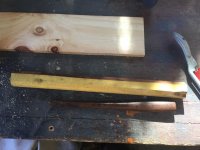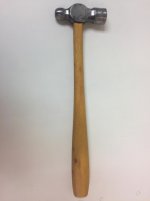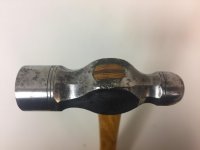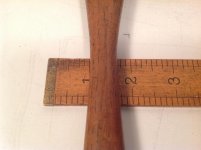Back in 1985-86, I was loaned from hydroelectric construction to a power transmission line construction project my (then) employer was doing. Being a Professional Engineer, I had to do inspections of a variety of deep caisson foundations for hollow-pole type transmission structures. These foundations had a rebar cage prefabbed out of number 16 (2" diameter) rebar. Every so often, the contractor would hit rock. Some investigation as to whether the rock was competent to take a "rock socket" was done. If the rock was competent, the rebar cage got shortened in the field. There were plenty of cutoffs of that 2" diameter rebar. I took a load of them with me. While on that same job, I made the acquaintance of a farrier/blacksmith. He had a nice shop and made his own tools. From working overseas, I had seen enough good tools forged, hardened and tempered from rebar to know that not all rebar is the "s--t steel" as is commonly believed. Rebar made to ASTM specs is often re-rolled from railroad rail, so has about 0.90% carbon, along with manganese. It will water harden. The blacksmith/farrier I had met knew this as well. When he saw the cutoffs of that 2" rebar, he asked if he could have some. He made hammers from that 2" diameter rebar. Nothing so fancy or so finished as the ball pein hammers made by machinists in this thread. The blacksmith made hammers for forging steel and turning horse shoes. He shod anything from light saddle breeds to heavy draft horses and did corrective shoeing, so said he was going to make some hammers and some anvil tools to suit his needs from that rebar.
I find it hard to believe a hammer head would be casehardened. For what the hammer head is, it sounds like more trouble than it is worth to caseharden a hammer head made of some lower-carbon steel. What I do know, from experience, is courtesy of the people out to save us from ourselves, commercially available hammer heads are sometimes not so hard as they used to be. In 1975, when I was leaving a jobsite/area being reassigned, a then girlfriend gave me a going away present. She went into Gruskin's Hardware ( a wonderful old store, since vanished) in New London, CT, and asked the men there for a blacksmith hammer. They sold her a nice 2 lb cross pein hand sledge, made by Germantown Tool. It has a nice heft to it. Unfortunately, in use, the head started to mushroom a bit at the edges of the striking face. I got in touch with Germantown Tool- probably long defunct as well. They told me they were not drawing the hammer striking faces to the higher hardness they had done previously, citing some new governmental regulations or specs. This was about the time that all sorts of information started getting stamped into hammer heads and striking tools (chisels, punches, etc) such as: "Wear goggles when using this tool". I found that business of stamping the obvious safety warnings into tools was BS. It made it nearly impossible to reforge worn out or broken-off striking tools due to the depth of the stamped letters.
I had a nice talk with Germantown Tool about the whole mess. They said it was a requirement as far as leaving the hammer striking faces a bit softer to avoid chunks spalling off if another hardened surface was struck, or if used in extremely cold weather.
40 + years later, on its third handle, and who-know-how-many dressings of the striking face, I am still using that Germantown hammer. On hot metal, it does not matter much if the face is a little softer. On cold work and striking cold chisels and punches, it is another matter. About 25 years ago, I decided I needed a straight peen hammer. I had a number of ball pein hammer heads laying around. I found a hefty one marked "Globemaster", which had come from a closed auto repair garage. I figured "Globemaster" was likely a cheap hammer from who-knew-where. I put it in the forge, got it hot and let is soak, then slow cooled. I reheated and started playing around with the ball pein end, expecting it to shatter when I started forging, as I had seen some other hammer heads do. This forged nicely.
It sparked like high carbon steel, and took hardness well. I put a chunk of steel in the eye of the head when reforging it, and the ball pein was heavy enough to forge into a reasonable straight peen, narrow, but OK for my purposes.
Hammer heads like a ball pein are best made by forging from a piece of tool steel or at least a steel with 0.60% carbon or better. Forging refines and creates a grain flow that is going to hold up a lot better in service when a hammer is used. Machining from solid bar cuts the rolling lines in the steel. I think of it as wood. If you cut a board to resemble a ball pein hammer head in sectional view, so the grain runs perpendicular to the striking faces and to the handle, you will have areas where the head reduces and necks down to meet the center portion of the head. That is wood that will be prone to splitting off if you were to use this wooden hammer. The grain of the board you cut the sectional view of the hammer head from is about how the grain flow or rolling lines in a piece of bar stock will run. If you hog a hammer head out of a piece of bar stock and harden it, the areas where there are discontinuities have to be deeply radius'd or tapered to avoid the head breaking in service.
Forging a hammer head from bar stock, most smiths will upset forge the ends of the stock. This compacts the grain and causes a nice grain flow that spreads out like it was mushroomed over. Necking the hammer head forging on fullers (anvil tools or dies in a power hammer) will curve that grain flow, following the shape of the head. I liken forging to the days of wooden ship building. In the days of sailing ships made of wood, shipwrights sought out trees that had crooks in them to use for the frames of the ships. Similarly, when blacksmiths and farmers made bob sleds for getting in wood or similar, they went after trees that had crooks in them, or heavy limbs with crooks. These were sawn out to use that curved grain to follow the curvature of the leading ends of the sled runners. I am old school, and forged tools and forged parts in certain applications always made sense to me. I liken working steel to knowing about the grain in lumber. How the steel is rolled or forged plays more of a role than many people realize. In making something so humble and common as a ball pein hammer, a forged head would be my preference, and would make a lifetime tool. There is a resurgence in blacksmithing, and the suppliers of blacksmith and farrier's tools offer hand forged hammers. Quite pricey, and quite interesting to see the different designs and craftsmanship. I have a bunch of hammers, ball peins, cross peins (aka "Engineers Hammers), sledges, the lone straight peen, and a load of anvil tools such as top hardies, top fullers, top flatters, etc. I used to grab any broken or cut off sledge handles on the jobs when I was working full time. Men would cut sledge handles short so they could use a heavier sledge (like 16 lb or 25 lb) in close quarters. I'd take the cutoffs of the handles home. If someone had a split handle, from missing a blow or two, I'd cut that off and take it home. Often, there was enough good hickory or ash to make handles for my hammers and anvil tools. I like to fit the handles to my hands. I maimed the right ring finger some 50 years ago when I was a kid. The doctor initially wanted to amputate, but I chased the surgeon out of the room and cursed and carried on until a young resident said he'd try to save the finger. He did. It works, though the nail is a mis shapen claw, and the "ball" of the finger is offset and compresses a bit differently than my undamaged fingers. Holding a hammer handle can get tiresome for that finger. I take a rasp and drawknife and sander and reshape or make hammer handles that fit my hand with the damaged finger. Light hammers are OK, but swinging something heavier one-handed for long periods does get to that finger. I appreciate a hammer that has good "heft", or "feel", aside from the shaping of its business ends. I also appreciate a well formed handle, perhaps more than a lot of people.


























